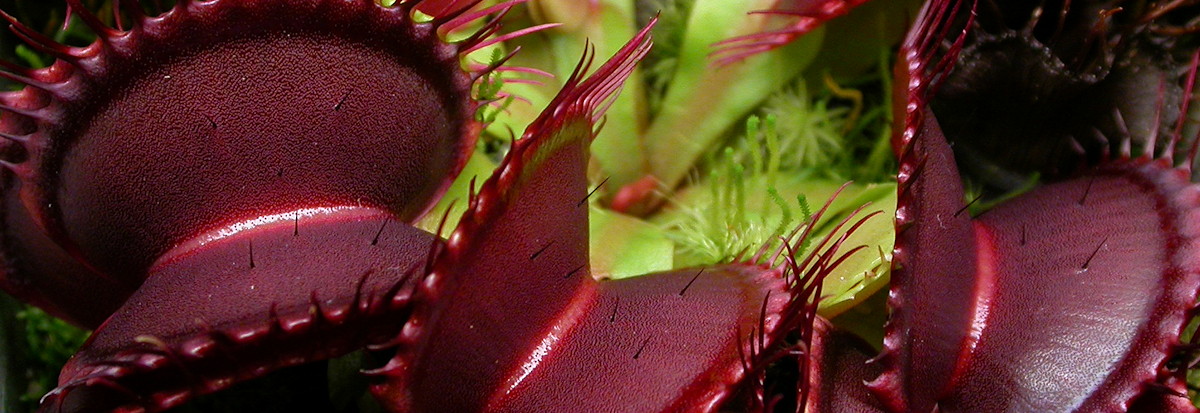
Dionaea muscipula 'B52' grown under LED lighting.
Dionaea muscipula, commonly called the Venus Flytrap, Venus Fly Trap, or VFT, is found naturally in the coastal plain of southeastern North Carolina and northeastern South Carolina. The plant is surprisingly adaptable considering its narrow distribution in the wild. It can be grown in outdoor bogs even in Canada if you know how to create the right conditions. It also makes a great house plant with supplemental lighting. No terrarium needed.
The main requirements for growing Dionaea muscipula are:
(1) VFTs need lots of light. Give it full sun outside if you can grow it outside. It also makes an excellent indoor plant but requires more light than it can get on a typical house window sill.
(2) The pot with the plant must always be sitting in pure water. If your tap water has a total dissolved solids (TDS) less than 90 ppm (check with your city, water company, well test, or measure with a TDS meter) you can use it for your carnivorous plants. If the TDS is higher than 90, use distilled, reverse osmosis, or clean rain water. Filtering water will NOT remove the dissolved salts. (There are "filters" that contain chemicals to remove salts from water. They do work but the "filter" must be replaced often or it will release accumulated salt into the "filtered" water.)
(3) VFTs must eat regularly. If the plant is not catching its own food, it needs to be fed in the traps with live insects, rehydrated dried blood worms, or other kinds of fish food high in insect-derived protein that can be conveniently rehydrated. If you use dead food, the traps need to be massaged to stimulate full closure and digestion.
If you just bought a plant please see the Check List for Growing Dionaea muscipula.
Dionaea makes a great indoor plant under artificial light. Who wants to hide their plants outside or in a greenhouse when you can have one or a dozen sitting right next to you in the house? In spite of what many people believe, VFTs do not require a terrarium nor do they require dormancy to survive long term indoors. The plants only require dormancy if they are going to experience freezing temperatures outside. Putting an indoor plant in the refrigerator to encourage dormancy is a waste.
VFTs will grow continuously and look nice indoors as long as they get enough light and are fed regularly. Give VFTs 15,000 to 25,000 Lux of white LED lighting (about 25 W per 25 cm (10 inch) diameter growing area (actual watts, not "watt equivalents")) for about 14 hours a day. Plants under purple LED plant lights will require only 12 W per 25 cm growing area but will not look natural unless there is enough white light. For more information on growing VFTs indoors year round, please see the CPN article Grow Venus flytraps indoors (PDF).
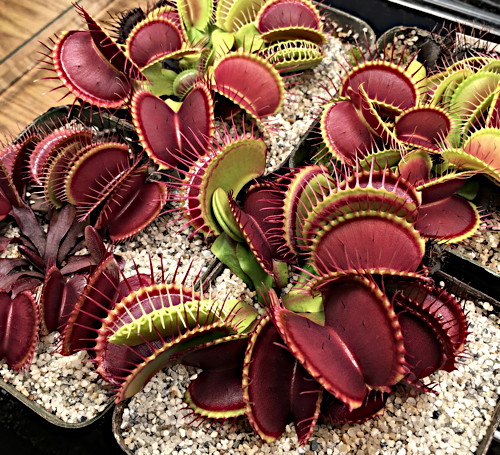
These VFTs have been growing indoors under constant light period for over 10 years. They get divided and repotted every year or two. These plants were divided and repotted 4 to 8 months before the photo was taken.
Rehydrated dried bloodworms are the easiest food to use to feed VFTs. I feed them when their growth slows down somewhat. The more you feed them, the larger they get and the more often they need to be repotted. Stop feeding them and they will decline. See Feeding Dried Blood Worms Step-by-Step for more information.
At some point the plant will grow across the pot and slam into the side or the soil will get to salty and the traps on new leaves will fail to develop. Divide and repot the plant to renew it. A well kept VFT will need to be repotted every year or so.
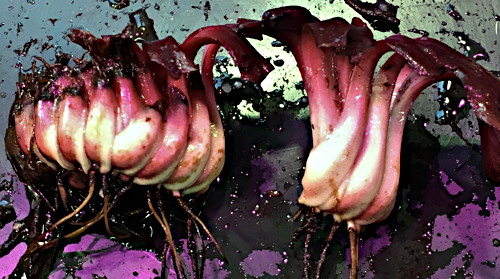
This Dionaea 'Akai Ryu' plant grew across its pot and is in the process of being repotted. The piece on the right has the growth point and enough old leaf bases to get it off to a good start in its new soil. The piece on the left can be broken up to make a over a dozen new plants. Please see Dionaea Leaf Pullings Step-by-Step on how to make new plants as well as how to pot the "mother" plant. Plants grown with a cm of pure sand on the surface are less likely to have their older leaves totally rot.
Dionaea muscipula isn't very picky about soil. It grows well in pure Sphagnum moss (live or from dried), pure Sphagnum peat, and the standard 1:1 peat:sand "CP mix". Avoid perlite, pumice, and other potentially salty soil components. What does matter is how tall the pots are and consequently how far the crown of the plant is from the water level. The plants do not enjoy being soggy but must always be wet. The wetter the soil the taller the pot. In shorter pots the soil should be more sandy. Avoid pure Sphagnum moss or pure peat in short pots. In any case the water level should always be more than 5 cm (2 inches) below the surface of the soil.
If you want to grow Dionaea muscipula from seed, sow the seeds of on the surface of your medium of choice. The seeds may be covered with 1 to 3 mm of washed quartz sand over CP mix. Live sphagnum can overgrow the plants so keep a close eye on the seedlings if you use it. Finely chopped long fibered sphagnum over CP mix or CP mix alone also work well germinating seeds. The main problem is the nutrients in peat encourage the growth of cyanobacteria (AKA bluegreen algae) that can overgrow the small, very slow growing seedlings. Washing the peat helps cut down on cyanobacteria and moss. However the nutrients in the peat, what small amount there is, give the small seedlings a boost. The soil should be saturated with pure water.
What you do after sowing the seeds depends on what works best for you. Everyone has their own preferred routine. I lightly spray the seeds with water and put the pots in plastic zip-lock bags under purple LED plant lights. A temperature between 20°C to 25°C (70°F to 80°F) works best. After the seedlings get a few true leaves (the ones with traps), I remove the pots from the plastic bags and move them to bright terrarium or greenhouse. Please see Sowing Seeds Step-by-Step for more details on starting seeds.
The seedlings are very slow growing. It could easily take 5 years to get a mature plant from seed if they are not fed regularly. Experts with greenhouses can get mature or close to mature plants in two to three years. You can get a mature plant in two years if you feed it in the traps as much as the plant can handle. But no one grows Dionaea from seed commercially except to find new varieties. The usual technique for commercial propagation is sterile culture also called tissue culture or micropropagation. They propagate only the very best selected plants which may be one in a thousand from seed. Expert growers may also fertilize their plants. This is tricky to do safely. DO NOT fertilize your plants unless you don't care if you kill them. Feed them in the traps with Dried Blood Worms.
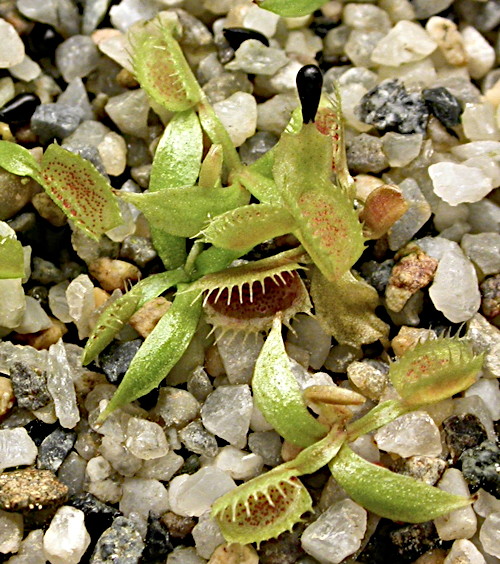
Young VFTs large enough to be fed a small piece of rehydrated dried bloodworm.
New Dionaea seedlings will tend to grow for about 4 months then stop growing. They are expecting winter to start a that point. They can be tricked by keeping them warm under intense light and feeding heavily. As soon as a new trap opens, feed it with a small piece of hydrated dried blood worm. When it reopens remove the remains of the previous meal. That will probably result in it closing the trap. When the trap reopens again in the next day or so, feed it again.
If you want to grow seedlings and non-display plants indoors and do not care how your plants look, grow them under purple LED plant lights. Figure at least 15W of purple LED plant lighting per 30 cm (12 inches) square of growing area. You can leave the lights on 14 hours a day or use a timer that adjusts the on time to match your natural day-length. If the lights are pure blue and red light, you may want to include some white light to be able to see the plants well.
If you live in USDA zone 9 and warmer, try to grow your larger seedlings and mature plants outside. They will grow best in full sun if you live in an area that is humid or cool in the summer. If where you live is hot and dry, full morning sun and then part shade is appreciated. The use of 10% or 20% shade cloth with full sun works well (if you can find it—most shade cloth is 50% or more and that is too shady). You will need to protect the plants from birds and other creatures.
In USDA zones 7 and 8, it is problematic growing Dionaea outside without a heated greenhouse but it can be done. Growing the plants in an in-ground bog is easiest. During the winter, if the temperatures don't stay below freezing for more than a week at a time you can keep the plants outside fully exposed to the rain and snow unless there is an early or late freeze. The plants will survive being frozen solid for a week or longer if they are fully dormant and protected from drying out. If they are not fully dormant, freezing weather can kill them. When the plants are being overly protected or have started to grow and then get frozen they are easily killed. Do not let them dry out as the biggest danger is freeze-drying. Use of pine needle mulch or row cover cloth helps prevent freeze-drying.
In very cold climates (USDA zone 6 and colder) the plants will require substantial protection if grown outside. It may be best to put the plants in a heated greenhouse, a south facing window of a garage, or cover them with a foot of straw or pine needles during the winter. Although it is probably a good idea to supplement the light if you have the plants in a garage window during the winter I do not recommend bringing them into the house or basement and putting them under lights for the winter unless you use a light timer that adjusts for your local day length. It will get them out of sync with the seasons. It is better to just keep them indoors under lights all the time than to switch back and forth.
— John Brittnacher
November 2001
Latest Update July 2019
For more information please see:
Check List for Growing Dionaea muscipula
Dionaea Leaf Pullings Step-by-Step
Dried Blood Worms Step-by-Step
Evolution of the Caryophyllales Carnivores
Degreef, John D. (1988) The Electrochemical Mechanism of Trap Closure in Dionaea muscipula. Carniv. Pl. Newslett. 17(3):80-83,91-94 ( PDF )
Degreef, John D. (1988) The Evolution of Aldrovanda and Dionaea Traps. Carniv. Pl. Newslett. 17(4):119-125 ( PDF )
Szesze, Michael (1995) A Venus Flytrap Flipbook. Carniv. Pl. Newslett. 24(1):20-21 ( PDF )
John Brittnacher (2019) Grow Venus flytraps indoors. Carniv. Pl. Newslett. 48(4):178-182. ( PDF )
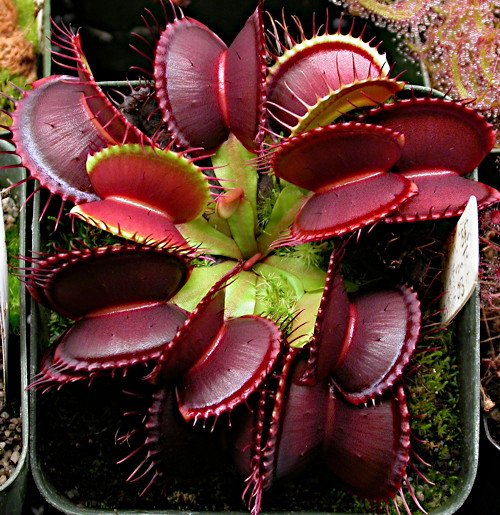
Dionaea muscipula 'B52' makes a great indoor plant. I has short petioles all the time unlike wild type plants that seasonally hold their leaves upright.
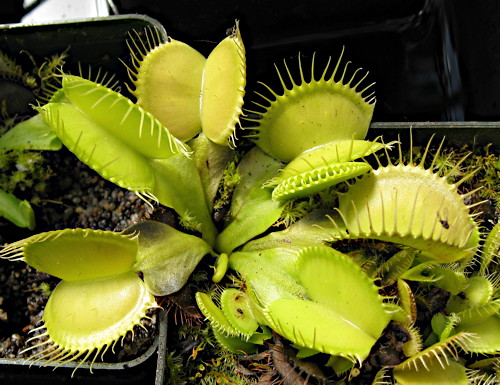
Dionaea muscipula 'Justina Davis' does not make red pigment so it is green even with lots of light.
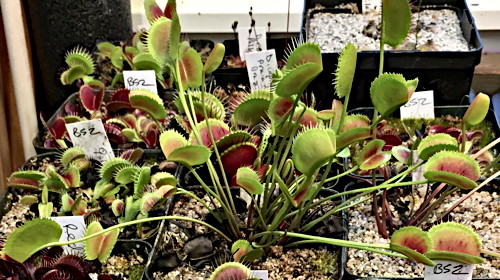
Dionaea muscipula 'Korean Melody Shark' has long, non-leafy petioles. The plant can take up a lot of space.
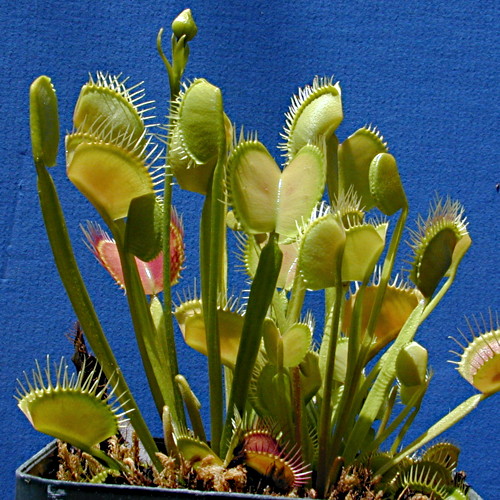
During the spring as the flower stalks emerge, the plants tend to put out upright leaves with long narrow petioles. Some cultivars do not produce upright leaves like these.
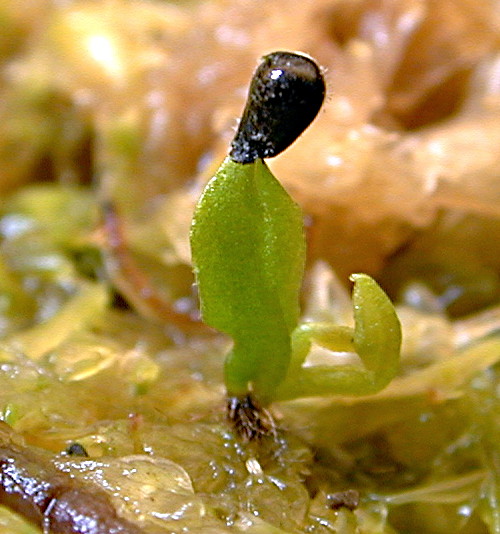
Dionaea muscipula sprout. Note the non-carnivorous cotyledons with the seed still attached. The first true leaves have traps.
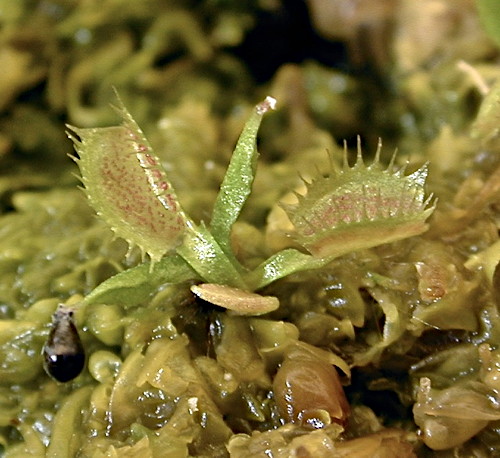
This is the same seedling a few weeks later.
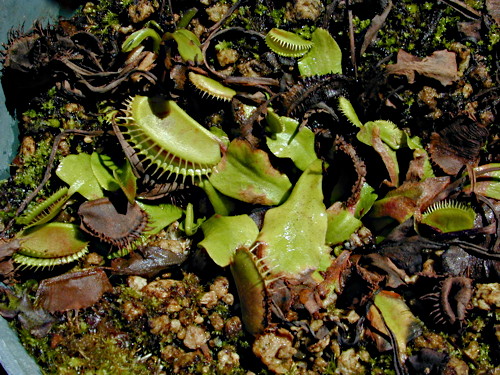
This is how healthy Dionaea plants look at least 3 month of the year while they are dormant outside. Some growers repot their plants every spring just as they start growing. These were repotted a week after this picture was taken.
